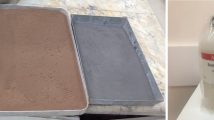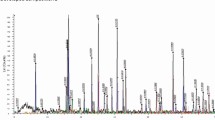The use of high-alumina nanotechnogenic raw material as grog was found to be expedient for increasing the heat-resistance of clinker brick. As the content of aluminum oxide Al2O3 in a ceramic body compositions increases, the heat-resistance increases and the CLTE decreases when the clinker brick is fired (1250°C). For Al2O3 content in the ceramic body from 41 to 43% the heat-resistance of the clinker brick reaches its maximum value and ranges from 11 to 13 cycles. Regression analysis was used to obtain a mathematical model to determine the heat-resistance of clinker brick at points that were not present in the experimental series.





Similar content being viewed by others
References
V. A. Kulikov, I. V. Kovkov, and V. Z. Abdrakhimov, “Clinker brick based on crude kaolin and sludges from alkali etching,” Steklo Keram., No. 1, 21 – 23 (2011); V. A. Kulikov, I. V. Kovkov, and V. Z. Abdrakhimov, “Clinker brick based on crude kaolin and sludges from alkali etching,” Glass Ceram., 68(1 – 2), 22 – 24 (2011).
P. P. Budnikov, V. L. Balkevich, A. S. Berezhnoi, et al., Chemical Technology of Ceramics and Refractories [in Russian], Stroiizdat, Moscow (1972).
L. Elstner, P. Jeschke, W. Kronert, and E. Protogerakis, “Thermoschockverhalten Feuerfester Baustoffe aus Zirkonium-dioxid, Teil III”, Experimentelle Untersuchunden, Sprechsaal, No. 115, 542 – 556 (1982).
W. D. Kingery, “Factors Affecting Thermal Stress Resistance of Ceramic Materials,” J. Am. Ceram. Soc., No. 38, 542 – 556 (1955).
D. P. H. Hasselman, “Unifed theory of thermal shock fracture initiation and crack propagation in brittle ceramics,” J. Am. Ceram. Soc., No. 52, 600 – 604 (1969).
V. F. Pavlov, A. S. Bystrikov, and N. I. Andreeva, “Effect of Li2O, Na2O, and K2O additions on phase changes during the firing of clays of different mineralogical composition,” Steklo Keram., No. 2, 38 – 48 (1970); V. F. Pavlov, A. S. Bystrikov, and N. I. Andreeva, “Effect of Li2O, Na2O, and K2O additions on phase changes during the firing of clays of different mineralogical composition,” Glass Ceram. 27(2), 112 – 114 (1970).
V. F. Pavlov, Physical and Chemical Principles of Firing Building Ceramic Articles [in Russian], Stroiizdat, Moscow (1977).
V. F. Pavlov, V. D. Kizaev, and V. S. Radyukhin, “Acid resistors with elevated heat resistance from mixes based on refractory clays,” Tr. Instituta NII Stroikeramiki, No. 52, 39 – 56 (1983).
R. M. Zaionts, “Acid resisting articles with high thermal stability,” Tr. Instituta NII Stroikeramiki, No. 32 – 36, 46 – 52 (1980).
V. F. Pavlov and T. E. Klimov, “Development of mix compositions based on Angrenskoe kaolin and the effect of the method of mixing on the properties of acid resisting articles,” in: Proc. of the Institute of NII Stroikeramiki, Research on the Use of Local Clays and Improvement of the Technology of the Production of Ceramic Articles [in Russian] (1980), pp. 104 – 144.
E. S. Abdrakhimova and V. Z. Abdrakhimov, “Thermomechanical investigations of ceramic brick,” Izv. Vyssh. Uchebn. Zaved., Stroitel’stvo, No. 7, 12 – 16 (2006).
A. I. Avgustinik, Ceramics [in Russian], Lenizdat, Leningrad (1975).
Jay L. Devore, Probability and Statistics for Engineering and the Sciences, California Polytechnic State University, San Luis, Obispo (2010).
E. S. Abdrakhimova and V. Z. Abdrakhimov, “On the question of using aluminum-containing nanotechnogenic raw material in the production of ceramic composite materials,” Materialovedenie, No. 12, 44 – 52 (2014).
T. I. Litvinova, V. P. Pirozhkova, and A. K. Petrov, Petrography of Nonmetallic Inclusions [in Russian], Metallurgiya, Moscow (1972).
E. S. Abdrakhimva and V. Z. Abdrakhimov, “Investigation of the crystallization of mullite during firing of acid resisting articles,” Novye Ogneupory, No. 4, 39 – 45 (2012).
G. V. Kukolev, Chemistry of Silicon and Physical Chemistry of Silicates [in Russian], Vyssh. Shkola, Moscow (1966).
Author information
Authors and Affiliations
Corresponding author
Additional information
Translated from Steklo i Keramika, No. 9, pp. 32 – 38, September, 2015.
Rights and permissions
About this article
Cite this article
Kairakbaev, A.K., Abdrakhimova, E.S. & Abdrakhimov, V.Z. Effect of High-Alumina Nanotechnogenic Petrochemical Wastes on the Heat Resistance of Clinker Brick. Glass Ceram 72, 335–340 (2016). https://doi.org/10.1007/s10717-016-9786-y
Published:
Issue Date:
DOI: https://doi.org/10.1007/s10717-016-9786-y




